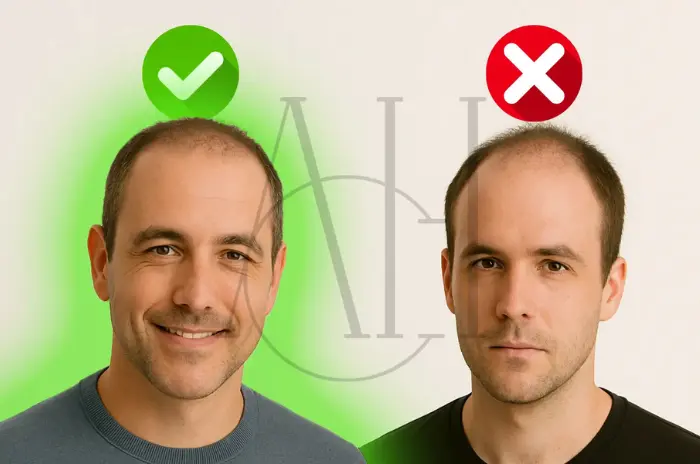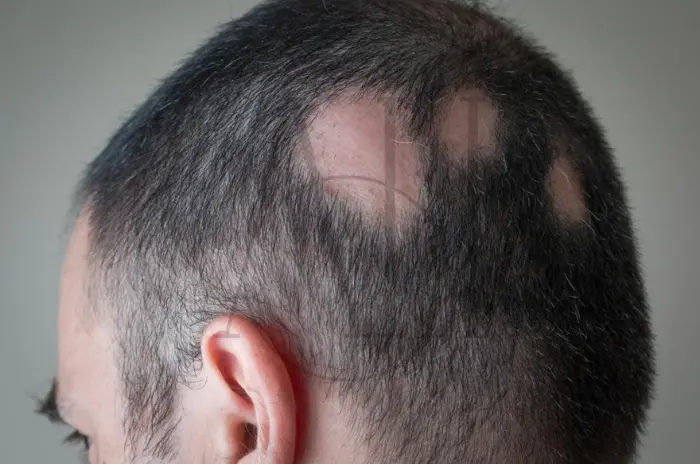Il trapianto di capelli è una procedura che cambia la vita a chi ne soffre. Ma la pazienza è fondamentale, perché i risultati richiedono tempo per manifestarsi. Questo blog fornisce una guida completa, mese per mese, alle tempistiche di crescita del trapianto di capelli, in modo che tu sappia cosa aspettarti in ogni fase del tuo percorso.
Table of Contents
ToggleIl viaggio verso la ricostruzione dei capelli
La perdita dei capelli può essere emotivamente impegnativa e il trapianto di capelli offre una soluzione promettente. Tuttavia, è essenziale comprendere il processo e stabilire aspettative realistiche. Dal recupero iniziale alla crescita completa dei capelli, questa tabella di marcia ti preparerà ad affrontare tutte le fasi del tuo percorso di restauro dei capelli.
Cosa succede dopo la procedura?
Dopo un trapianto di capelli, il cuoio capelluto inizia il suo percorso di recupero e di crescita dei nuovi capelli. Ecco una panoramica di ciò che accade nella prima settimana:
Dal 1° al 7° giorno: recupero immediato
- Croste e arrossamenti: L’area trattata può presentare arrossamenti e piccole croste intorno agli innesti.
- Lievi disagi: Gonfiore e indolenzimento sono normali e di solito si attenuano nel giro di pochi giorni.
- Segui le istruzioni per la cura successiva: Il chirurgo ti fornirà le linee guida per lavare i capelli ed evitare attività faticose.
Consigli per la prima settimana
- Tieni pulito il cuoio capelluto, ma evita di strofinarlo con forza.
- Dormi con la testa sollevata per ridurre il gonfiore.
- Evita la luce diretta del sole sul cuoio capelluto.
Dalla seconda alla terza settimana: Fase di eliminazione
Entro la seconda o terza settimana, potresti notare qualcosa di inquietante: i capelli trapiantati cadono. Non farti prendere dal panico! Questa fase, nota come “shock loss”, è del tutto normale.
- Perché accade: I follicoli piliferi entrano in una fase di riposo chiamata fase telogen.
- Cosa aspettarsi: La maggior parte dei capelli trapiantati cadrà, lasciando un aspetto a chiazze.
Come gestire questa fase
- Rimani positivo e abbi fiducia nel processo.
- Evita di manipolare il cuoio capelluto per proteggere i follicoli.
Mese 1 – 3: Fase di quiescenza
La fase di quiescenza può mettere a dura prova la tua pazienza, perché in questo periodo la crescita visibile è scarsa o nulla.
1°mese
- Il cuoio capelluto guarisce completamente e qualsiasi arrossamento o crosta persistente dovrebbe scomparire.
- I follicoli trapiantati rimangono inattivi sotto la pelle.
2° mese
- La crescita dei capelli potrebbe essere ancora minima, ma i nuovi follicoli si stanno sviluppando sotto la superficie.
3° mese
- Potrebbero iniziare a spuntare dei peli sottili e fini.
- Questa crescita iniziale potrebbe non essere molto evidente, ma è un segno che il progresso è in corso.
Mese 4-6: inizia la crescita
In questa fase vedrai i primi significativi miglioramenti nella crescita dei capelli.
4° mese
- Inizia una notevole crescita dei capelli.
- I nuovi capelli possono apparire più fini o di colore più chiaro, ma con il tempo si ispessiscono.
5°mese
- La densità dei capelli migliora e un maggior numero di follicoli entra nella fase anagen (di crescita).
- Potresti essere in grado di acconciare i tuoi capelli, anche se i risultati sono ancora incompleti.
6° mese
- Almeno il 50% dei risultati finali può essere visibile.
- I capelli appaiono più spessi e la copertura migliora notevolmente.
Mese 7-9: Progressi sostanziali
A questo punto, potrai notare un aumento significativo della densità e della lunghezza dei capelli.
7° mese
- I nuovi capelli continuano a crescere sia in lunghezza che in spessore.
- I capelli hanno un aspetto più naturale e si integrano bene con quelli esistenti.
8° mese
- La crescita accelera e le zone calve si riempiono.
- Le opzioni di styling si ampliano quando i capelli acquistano volume.
9° mese
- La maggior parte dei pazienti vede il 70-80% dei risultati finali.
Mese 10-12: Risultati finali
Gli ultimi mesi segnano il culmine del tuo percorso di trapianto di capelli.
10° mese
- La consistenza e la qualità dei capelli migliorano.
- I capelli trapiantati si fondono perfettamente con le aree circostanti.
11° mese
- Tutti i punti sottili rimasti vengono riempiti.
- I capelli appaiono più spessi, più sani e più robusti.
12° mese
- I risultati finali sono stati raggiunti.
- Goditi una densità di capelli completa, un’attaccatura migliorata e risultati dall’aspetto naturale.
Fattori che influenzano la crescita del trapianto di capelli
Sebbene la maggior parte dei pazienti segua una tempistica simile, diversi fattori possono influenzare la velocità e la qualità della crescita dei capelli:
1. Processo di guarigione individuale
Ognuno guarisce in modo diverso, quindi la tua tempistica potrebbe variare leggermente.
2. Tipo e consistenza dei capelli
I capelli fini o ricci possono apparire inizialmente meno densi ma miglioreranno con il tempo.
3. Competenza del chirurgo
L’abilità e la tecnica del tuo chirurgo giocano un ruolo fondamentale per il successo del tuo trapianto.
4. Conformità alle cure successive
Seguire le istruzioni per la cura successiva assicura condizioni ottimali per la crescita dei capelli.
Consigli per ottimizzare la crescita dei capelli
1. Mantenere una dieta sana
Gli alimenti ricchi di vitamine e proteine, come uova, pesce e verdure a foglia verde, favoriscono la crescita dei capelli.
2. Usa i prodotti per capelli consigliati
Gli shampoo e i sieri prescritti dal tuo chirurgo possono favorire una crescita sana.
3. Evita il fumo e l’alcol
Queste abitudini possono compromettere l’afflusso di sangue al cuoio capelluto e rallentare la crescita.
4. Sii paziente
I risultati del trapianto di capelli richiedono tempo, ma l’attesa ne vale la pena.
Miti comuni sulla crescita del trapianto di capelli
Mito 1: i risultati sono immediati
Il restauro dei capelli è un processo graduale; i risultati completi richiedono 12-18 mesi.
Mito 2: I capelli trapiantati cadono in modo permanente
Sebbene inizialmente si verifichi uno spargimento, i follicoli trapiantati fanno crescere nuovi capelli permanenti.
Mito 3: Puoi riprendere immediatamente le tue attività
La cura post-procedura è essenziale per garantire una crescita di successo.
Fiducia nel processo
Il trapianto di capelli è un investimento su se stessi e i risultati possono essere trasformativi. Capire le tempistiche di crescita ti aiuta a stabilire aspettative realistiche e ti assicura di essere preparato per ogni fase. Dallo spargimento iniziale ai risultati finali, la pazienza e la cura adeguata sono le chiavi del successo.
Se stai pensando di sottoporti a un trapianto di capelli, consulta una clinica di fiducia per discutere i tuoi obiettivi e creare un piano di trattamento personalizzato.




